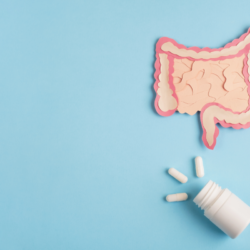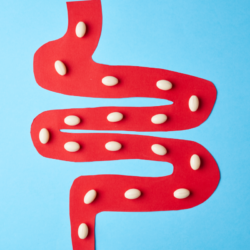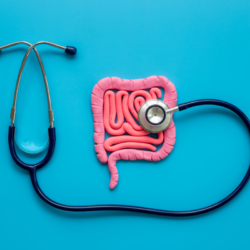Pharmacomicrobiomics is an emerging field of science that explores the complex interactions between our intestinal microbiota and the medicines we take. Understanding these interactions is essential for maximising the effectiveness of drug treatments and minimising side effects.
Pharmacomicrobiomics, an emerging branch of science focusing on the interactions between microbiota and drugs, has become increasingly important in understanding the variability in patients’ responses to drug treatments. The intestinal microbiota, in particular, can activate, inactivate or modify oral drugs into toxic metabolites. This bidirectional phenomenon involves not only changes in the composition of the microbiota but also changes in the clinical efficacy of drugs.
What is pharmacomicrobiomics?
Pharmacomicrobiomics is a sub-discipline of pharmacology that studies the interaction between the human microbiome and drugs (4). The microbiome is made up of various micro-organisms, such as bacteria, viruses and fungi, that reside in different anatomical sites in the body, including the gastrointestinal tract, skin and respiratory tract. These micro-organisms can have a significant impact on the efficacy and toxicity of medicines.
In the pharmacological context, the microbiome can affect a number of parameters, such as the bioavailability, metabolism and elimination of drug substances. For example, certain intestinal bacteria can metabolise a drug into a more active form or, conversely, into a less effective form. These interactions can therefore either increase or reduce the therapeutic efficacy of the drug in question.
Pharmacomicrobiomics uses a variety of methods, from metagenomics to mass spectrometry, to characterise the microbiome and its interactions with drugs. The aim is to integrate this data into the process of developing new drugs and personalising pharmacological treatments, with a view to optimising therapeutic efficacy and minimising side effects.
Pharmacogenomics and pharmacomicrobiomics: what’s the difference?
In the constantly evolving ecosystem of personalised medicine, pharmacogenomics and pharmacomicrobiomics are emerging as two disciplines which, although closely related, have distinct focuses and applications. Both aim to optimise drug treatment by taking into account individual characteristics, but they do so by exploring different biological domains.
What is pharmacogenomics?
Pharmacogenomics is a branch of genetics which studies how an individual’s genes influence their response to drugs (5). This discipline uses DNA sequencing and genomic analysis techniques to identify genetic variations that may explain differences in drug efficacy and susceptibility to side effects. The aim is to adapt the choice of medication and dosage to individual genetic profiles, enabling more targeted medicine that is less prone to adverse effects.
Pharmacomicrobiomics
Pharmacomicrobiomics focuses on the interaction between the human microbiome (the collection of micro-organisms residing in our bodies) and medicines. It explores how variations in microbial composition, particularly in the gastrointestinal tract, can influence the absorption, metabolism and elimination of different drug substances. The aim is to integrate this information to improve therapeutic efficacy and minimise side effects.
Points of divergence
The key element that distinguishes these two disciplines is their object of study. Pharmacogenomics focuses on human DNA and its impact on drug response, while pharmacomicrobiomics studies the influence of the microbiome on these same parameters. While pharmacogenomics may require a single genetic analysis to establish a profile, pharmacomicrobiomics may require more frequent analyses, as the microbiome can change in response to various factors such as diet, age and exposure to antibiotics.
Which drugs affect the gut microbiota?
In this section, we’ll look at the drugs that affect the gut microbiota and why this is important for your health.
Proton pump inhibitors (PPIs)
PPIs are widely prescribed for the treatment of acid-related disorders. However, their chronic use has been associated with changes in the composition of the intestinal microbiota. Studies have shown a decrease in bacterial diversity and significant taxonomic changes, including an increase in Enterobacteriaceae families and a decrease in Ruminococcaceae. These alterations could contribute to enteric infections such as Clostridium difficile'(1).
Metformin
Used primarily to treat type 2 diabetes, metformin also appears to influence the intestinal microbiota. Studies have shown changes in more than 80 bacterial species (2), including an increase inEscherichia coli and a decrease inIntestinibacter. These changes may partly explain the therapeutic effects of metformin, as well as some of its gastrointestinal side effects.
Impact on anti-tumour response and immunotherapy
The composition of the intestinal microbiota has also been associated with the anti-tumour response and clinical efficacy of treatments by inhibiting immune checkpoints. Studies have shown that changes in the composition of the microbiota can influence the efficacy of immunotherapy in the treatment of cancer (3).
The impact of laxatives on the intestinal microbiota
Taking into account the microbial changes induced by laxatives needs to encompass several variables, including intestinal transit time, stool consistency and bacterial load per sample. Studies in mouse models have shown a significant increase in Bacteroides species following administration of polyethylene glycol (PEG). This modification had long-term repercussions on the composition of the intestinal microbiota, also affecting innate and adaptive immune responses. In addition, the S24-7 family within the order Bacteroidales was replaced entirely by a proliferation of the Bacteroidaceae family. These changes were permanent unless the S24-7 family was reintroduced (6).
Bi-directional influence of the microbiota on drugs
While pharmacogenomics studies the effects of variations in the human genome on drug disposition and action, pharmacomicrobiomics is emerging as a natural extension. This discipline aims to understand how the gut microbiota, often referred to as the‘second human genome‘, can influence the bioactivity, bioavailability and toxicity of drugs.
Suggested mechanisms for the impact of drugs on the microbiota
Two main mechanisms have been proposed to explain how drugs can influence the composition of the microbiota. The first is the translocation of microbiota from other body sites to the intestine. For example, proton pump inhibitors (PPIs) reduce the stomach acid barrier, allowing oral microbes to pass into the intestinal tract. The second mechanism suggests that drugs can directly affect bacterial growth by modifying intestinal microenvironments.
Mechanisms of microbial impact on drug efficacy and safety
Studies have shown that intestinal microbes can transform the enzymatic structure of drugs, thereby affecting their bioactivity. For example, the oral antiviral drug Brivudine is metabolised to bromovinyluracil by the microbiota, resulting in liver toxicity. This metabolic transformation could be attributed to specific species such as Bacteroides thetaiotaomicron and Bacteroides ovatus (7).
The impact of statins on the microbiota
Statins inhibit the enzyme 3-hydroxy-3-methylglutaryl coenzyme A reductase (HMG-CoA reductase), which is involved in cholesterol biosynthesis. This enzyme is present not only in humans but also in certain bacterial organisms, such as Enterococcus faecalis and Enterococcus faecium.
Complex interactions
The interactions between statins, bile acid metabolism, cholesterol synthesis and the intestinal microbiota are complex and have been the focus of numerous recent studies. Particular species of microbiota, including well-studied probiotic strains such as Lactobacillus and Bifidobacterium, are crucial sources of a group of enzymes known as bile salt hydrolases (BSHs).
Bile salt metabolism
Bile salts, synthesised from cholesterol by the liver, are metabolised by the intestinal microbiota into a variety of bile salt derivatives. These derivatives are then reabsorbed and further metabolised by the liver, generating a wide variety of complex bile salts that aid digestion and may offer protection against harmful organisms such as Clostridium difficile.
The potential effects of statins on the microbiota
Due to the inverse correlation between LDL-cholesterol concentrations and circulating bile acids, it has been hypothesised that the cholesterol-lowering effect of statins may be linked to the activity of bacteria containing BSH, such as Lactobacillus. A randomised, placebo-controlled clinical trial involving 127 participants (8) showed that treatment with the probiotic Lactobacillus reuteri significantly reduced LDL-cholesterol levels.
Aspirin, coffee and the intestinal microbiota
It is interesting to note that coffee, a beverage consumed daily by many people, can significantly affect the intestinal microbiota. A prospective study (9) showed that coffee bean extract altered the biodiversity of the intestinal microbiota. This change is reflected in an increase in Lactobacillaceae and Muribaculaceae organisms and a reduction in Proteobacteria, Helicobacteriaceae and Bacteroidaceae concentrations.
Bio-availability of aspirin
The same research group also evaluated aspirin blood concentrations in mice and adult men treated with a combination of coffee bean extract and aspirin. The intestinal microbiota normally hydrolyses aspirin into an ionised form that is less likely to be absorbed in the intestines. However, coffee bean extract inhibits the activity of certain intestinal microbes, resulting in an increased concentrations of the non-ionised and therefore highly bioavailable form of the drug. It is important to stress that this absolute increase in absorption was nevertheless very small.
Is aspirin a cure for cancer?
In addition to its cardiovascular uses, aspirin may also have a protective effect against colorectal cancer by modulating intestinal flora. A randomised controlled trial conducted by Prizment and colleagues on 50 patients showed that a 6-week course of aspirin was associated with an increase in the number of Akkermansia organisms (10). Akkermansia organisms were associated with improved survival and anti-cancer immune responses in colorectal cancer patients. In addition, aspirin reduced the concentrations of Parabacteroides and Dorea species, which are generally increased in these patients.
How do drugs influence the intestinal microbiota?
Exploring the interactions between the intestinal microbiota and various non-antibiotic drugs is opening up new prospects for optimising healthcare. It is becoming increasingly clear that these drugs, ranging from proton pump inhibitors to antidepressants, can have a significant impact on the composition and function of the intestinal microbiota. This interaction is not unilateral; in fact, changes in the intestinal microbiota can in turn affect the efficacy of drugs, even altering their bioavailability and toxicity.
The mechanisms underlying these interactions are complex and involve, for example, changes in resistance to intestinal colonisation, which can favour infections such as Clostridium Difficile. In addition, the impact of the microbiota on the efficacy of anti-cancer treatments, particularly immune checkpoint inhibitors, adds a further layer of complexity and clinical importance.
Clinicians need to integrate this knowledge into their practice, as it is no longer just about the effect of antibiotics on the gut microbiota. Non-antibiotic drugs also have a role to play and can have an impact on health. The emerging field of pharmacomicrobiomics offers exciting opportunities for the future, including targeted modulation of the microbiota to improve the efficacy of treatments. Clinical trials are currently underway, and the data they generate will undoubtedly influence future clinical guidelines.
This rapidly expanding body of knowledge suggests an imminent re-evaluation of current clinical protocols, and augurs well for more personalised and effective therapeutic interventions in the near future.
Source:
- (1) http://www.ncbi.nlm.nih.gov/pubmed/28629876
- (2) http://www.ncbi.nlm.nih.gov/pubmed/26633628
- (3) http://www.ncbi.nlm.nih.gov/pubmed/29097493
- (4) https://www.larevuedesmicrobiotes.fr/numeros/numero-19-microbiotes-reponse-aux-traitements-et-metabolisme-des-medicaments
- (5) https://www.ncbi.nlm.nih.gov/pmc/articles/PMC7145132/
- (6) http://www.ncbi.nlm.nih.gov/pubmed/30858400
- (7) http://www.ncbi.nlm.nih.gov/pubmed/30733391
- (8) https://pubmed.ncbi.nlm.nih.gov/22990854/
- (9) https://pubmed.ncbi.nlm.nih.gov/35456580/
- (10) https://pubmed.ncbi.nlm.nih.gov/32770859/





